Ellen and Jim Have a Blog, Too
We are two part-time academics. Ellen teaches in the English department and Jim in the IT program at George Mason University.


_Pallisers_ 4:8: In the thick of life, politics & marriage: Phineas v Laura (Summary of Episodes) (2) · 17 February 08
Dear Harriet,
Yesterday I sent along a thematic and structural analysis of Pallisers 4:8, “In the thick of life, politics & marriage: Phineas & Laura” (Donal McCann & Anna Massey); today I want to add to that, another concise summary of the individual episodes, with brief commentary and stills.
The relationship of 4:7 to 4:8 is to have set the terms of what we are seeing. Pallisers 4:7 is made up of two very long salon scenes (Episode 31, “Entertaining,” the second scene Lady Glen’s (Susan Hampshire) first political party (33 smaller conversations or scenes are in this); Episode 32, “Sizing Up Finn,” the dinner party at Lord Brentford’s (Lockwood West) where we see personalities and personal politics unroll before our eyes; this is alternated with scenes from the Bunce household [Haydn Jones & Brenda Cowling] also on politics); and a long episode (33, “Loughlinter”) where again we are introduced to the main politicians (and Madame Max [Barbara Murray] may be said to be a female politician in private life) at Loughlinter, hear key issues and principles discussed, and watch the characters’ interaction, see them align themselves or inadvertently make enemies (Erle [Moray Watson] feels jealous towards Phineas & Dolly [Donald Pickering] resents him as an upstart). The point of 4:7 is also to suggest the price the male beginner is paying (the loss of Mary Flood Jones (Maire Ni Ghrainne), harassment for a debt Phineas did not himself contract).
4:8 is Raven’s attempt to explore political life from many angles; Trollope does this novelistically in Phineas Finn, Raven does it filmically in Pallisers 4:8. Of course they meet one another in the use of dramatic scenes, but most of Raven’s are invented, or thorough rearrangements of something that occurs in Phineas Finn with matter taken from various parts of the novel transformed by the new context.
Volume 4, Part 8, Episode 36. “Finn Backs Down.” Scene 1) Parliamentary Chambers: Turnbull (Edward Burnham) publicly harasses Monk (Bryan Pringle) over Monk’s refusal to include a provision for the secret ballot in the reform bill; Barrington Erle (Moray Watson) attempts to give Phineas his big chance to defend Monk and Phineas finds he hasn’t the presence of mind & courage:
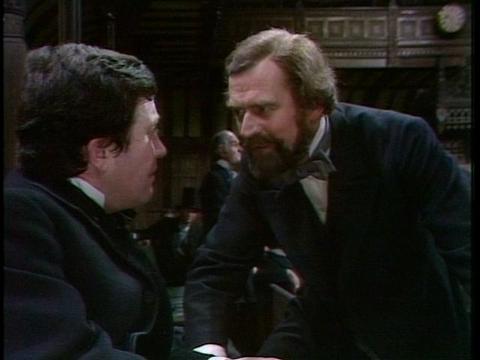
Phineas asked to pull his weight by Erle; he cannot as yet
The scene ends on close-up of Phineas’s distressed face. Scene 2) Grovesnor Square Sunday, large drawing room: Laura in black, reading a novel in a darkened room; Phineas comes to her to confess his failure; she supports & consoles him; Violet Effingham (Mel Martin) comes in with much irony at the way the Kennedy household spends its gloomy day; she’s going to evensong as the cheeriest thing available and Phineas accompanies her outsid, meeting Erle on the way in. Scene 3) Vestibule outside room in Grovesnor Square: Phineas and Violet, where he tells her he is to hunt with Chiltern (John Hallam) and she urges him to tell Chiltern to be careful (not risk his life). Scene 4) Return to drawing room, Grovesnor Square: Erle and Laura talk politics (Turnbull pressuring Liberal Party by use of radicals to include secret ballot; Tories might combine with Tories again; Kennedy comes in and coldly prevents the talk, Erle leaves, Kennedy then prevents Laura from reading her novel while he sermonizes; she claims headache, & he leaves, scene ends on close-up of her repressed depressed face.
Scene 5) Corridors outside Parliament: Phineas intervenes between Erle and Fitzgibbon (Neil Stacy) in a desperate unavailing attempt to get Fitzgibbon to pay Mr Clarkson (Sidney Bromley):
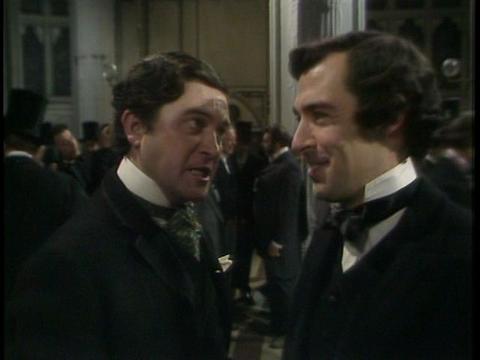
Phineas not succeeding in pressuring Fitzgibbon to pay
Episode 37. “Duke’s Interest.” Scene 6) Madame Max’s apartment in London: she plays the piano and sings with Dolly Longestaffe and then Erle, a song from Much Ado About Nothing: “Men were deceivers ever.” The room is an exquisitely feminine boudoir in which she entertains; they discuss Kennedy’s anti-life (“uncivilized”) stance; she calls Lady Laura “a Jill-in-the-box” & defends Phineas against the envy & calumny of these two men (they see him as a “smarmy” sycophant), and then attempts to get them to leave before the Duke of Omnium is to come; but he is early; we do not see him, only Erle and Longestaffe’s faces bowing (they assume a liaison).
Scene 7) Phineas’s lodgings in the Bunce household; Mr Clarkson cheerfully harasses and threatens Phineas; he helps himself to Mrs Bunce’s (Brenda Cowling’s) tea and muffins, and ignore Bunce (Haydn Jones) brining in a hip bath for Phineas. A scene of open stress & home-y-ness which contrasts with all the upper class scenes.
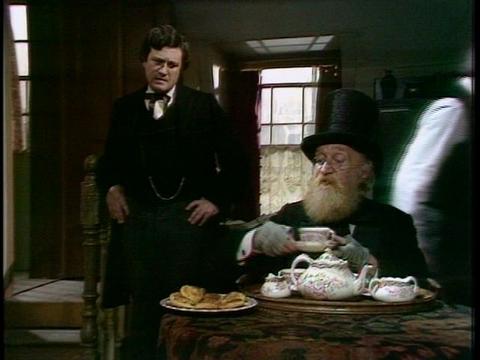
Clarkson harasses Phineas by taking over Mrs Bunce’s muffins
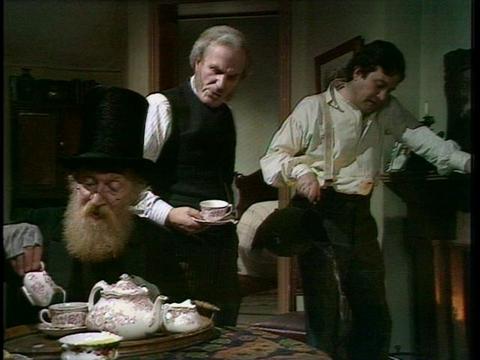
Clarkson harassing Phineas by refusing to leave after Mr Bunce has brought the hip bath; Phineas has a party to get to
Scene 8) London home of Pallisers, 24 Park Lane, small drawing room: establishment shot is of baby’s feet, and a woman’s hands helping him to take tottering steps. Throughout the series from the time of the heir’s birth, we are reminded he is growing up, is centrally important as a coming Duke, and this is done by presenting Lady Glencora (Susan Hampshire) as intensely fond and affectionate, thus also anticipating their close relationship and congeniality to come. Here Plantagenet (Philip Latham) mildly disapproves of her baby-talk encouraging the child in amoral desires (riches, pride, sweetmeats) and this anticipates his conflict with the son who will emerge. Barrington Erle comes in, calls the child “enchanting,” but child is sent away with (convenient) nurse and Erle reveals Duke of Omnium visits Madame Max, which worries Lady Glen. This is one of the scenes which keeps the Palliser matter continuous and prepares for the last parts (9:19-12:26) which resumes the Palliser matter only this time as a political and new generation story.
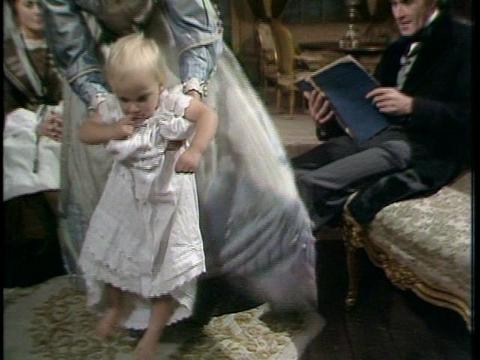
Plantagenet watches Lady Glen help little Planty take his first steps
Scene 9) The Willingford Hunt: it appears to be a filmed real hunt, with stunt man standing in for lookalikes of Phineas and Chiltern; appropriate for a Trollope novel, it’s lovely to watch as pastoral landscape.
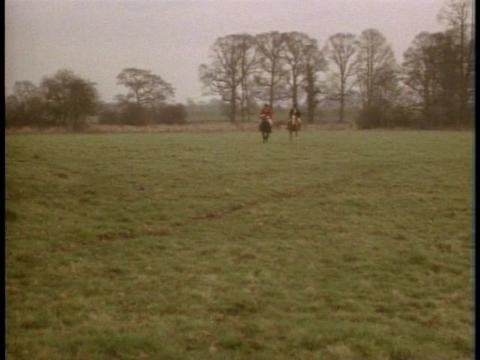
Phineas and Chiltern (stunt men) at the Willingford Hunt
The film-makers stretch the generic capacities of televisual art when he has a hunt, and when the has mob assembly scenes. It is part of the conservative heritage aspect of the films: we were to delight in Matching Priory and English history; we are to be proud of the scenes in the Parliament for we are supposedly seeing progress slow but sure. I can imagine a viewer in the 1970s and one today who lives in England congratulating him or herself on
their history. The Pallisers is a Whiggish Heritage film.
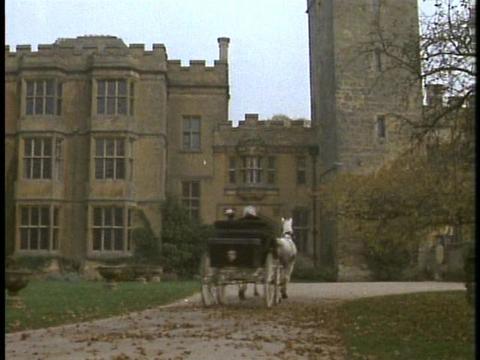
Our first full view of Matching Priory, Episode 2:3, Lady Glen bringing her guest, Alice Vavasour (Caroline Mortimer) in while recounting the history of the place & family
Episode 38. “Protesters.” Scene 10) Large drawing room, Pallisers’ home, where we have seen parties take place before. Lady Glen is instructing Collingwood on where to place what (she says we need less cake and more sandwiches, a line which harks back to a complaint of Dolly’s to Fitzgibbon at her first party that there were too many cakes and not enough sandwiches); Plantagenet comes in; she is now enormously pregnant, and becomes (“like a woman”) upset by a mouse; he comforts her, would rather she stop this entertaining, but she suggests it’s essential for his career; and he acquiesces in whatever she wants. It is she who wants a boy, to “secure the line,” now playing her role as upholder of the establishment. More Palliser matter.
Scene 11: Out in hunting fields, Phineas rescues and succours the badly hurt Chiltern, who insists on his love for Violet but says he will not ask her to marry him again. Scene 12) Lord Brentford’s home in London. Phineas has told of Chiltern’s fall and is thanked by Violet, Laura & Brentford; Brentford asks Laura for private conversation (it emerges Kennedy now asking for her dowry—in the novel it’s hinted she has stopped having sex with Kennedy, i.e., doing her duty and so he wants compensation; it’s a problem whether Raven expects us to remember this and bring it in here; he does make the lack of sex in the marriage obvious in a later Part). Finn attempts to begin wooing Violet himself, but is pushed away by Violet who however encourages him to come visit her again when they walk to the door; Laura returns: Laura shows suspicion and jealousy of Violet over Finn; unlike Trollope Violet does suggest she is drawn to Phineas (in Trollope’s novel the narrator only confirms Violet was tempted just before she accepts Chiltern after discovering that Finn had earlier chased Lady Laura so that his love in her estimation is shallow and fickle and perhaps self-interested, all of which is utterly unlike Chiltern’s. They speak of possible riots as they walk out, and the scene dissolves into
Scene 13) A street scene where we are to take there is an enormous crowd, brought there to bring pressure on Parliament to pass the reform bill and include the secret ballot.
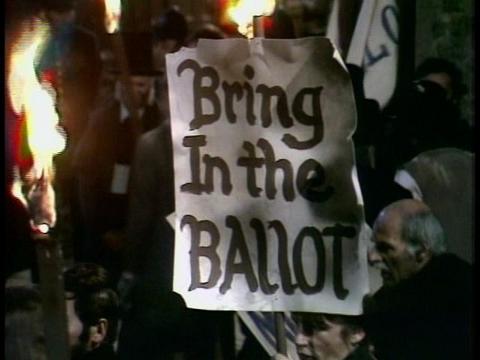
Crowd scene outside parliament
A very effective scene of Mildmay (Norman Shelley), who is against the ballot, arriving in carriage; he is booed and crowd surges around him, police keeping people off; Bunce and a friend are there for us to identify with; Turnbull then arrives and whips the crowd up. Scene 14) Inside Parliamentary chamber again. Mildmay’s speech. Booed. Scene 15) Outside in streets, and Bunce one of those calling for “no violence.” Bunce is meant to be a working class hero (it’s the threat of violence that arguably leads to powerful people yielding some decent legislation). Scene 16) Turnbull castiging and humliating Monk Here is where Phineas attempts to defend the agonized Monk (as Turnbull speaks against him as a “grave embarrassment”) and flubs it, loses all presence but we are to see that he gains a friend in Monk because he tried; he is not mocked by his fellow members but applauded. Erle gets up, and much talk is going on at once, including Monk asking Palliser if Palliser thinks they will lose and Palliser replying “I think the votes may just turn it against us.” Scene 17) Back in the streets: Turnbull coming out and we see Monk and Finn walk out a back door and watch the scene through a gate.
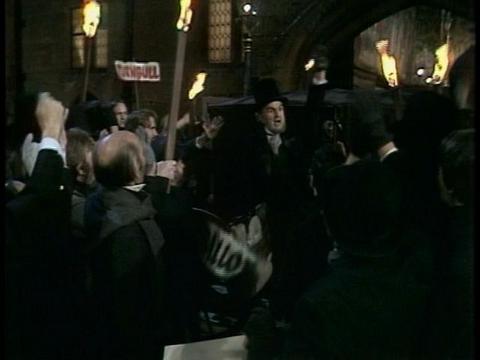
Crowd scene, Turnbull addresses his supporters
Bunce so excited wants to shake his hero’s hand, but instead he is hauled off by the police.
Episode 39. “Helping Mr Bunce.” Scene 18) Phineas’s lodgings, dark sky, after midnight. A frantic Mrs Bunce wakes Phineas up with the news Bunce has been “took.” Her grief touching.
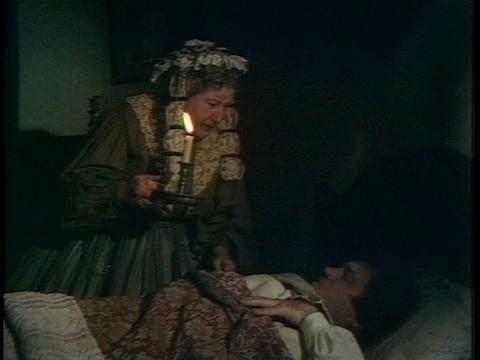
Phineas awakened by a frantic Mrs Bunce because Mr Bunce was “took” by the police
Scene 19) The police station. Phineas uses his status as a gentleman, together with some bills, to free Bunce. This is a scene I remembered for a long time after I first saw the series, and when it played I half-remembered it again. In Trollope’s PF it takes Phineas weeks to try to help free Bunce, and then it was not Phineas who did anything, but time and the process of law in the era. Then Bunce wants some revenge; his pride and self-esteem are hurt, and he tries to sue; Mr Low, Phineas’s mentor, the lawyer, tries to discourage Bunce from wasting his time and money, but Bunce won’t listen. Trollope uses the occasion to delineate how the policeman on the street sees the issue. Again
and again each incident in PF is developed to describe some aspect of how political struggle works out for real.
In the film Raven wants a piquant scene, and he does support the establishment: So we get a scene where being a gentleman counts and the sergeant frees Bunce on Phineas’s say so—with a bribe of course. We get a little semi-comic drama of incipient male cronyism in the interaction between Phineas and the sergeant who forces Phineas to give him more money (bills) instead of coins. We get them smiling at one another as they share a drink. I thought to myself here is part of the real bedrock of hostility to women in public life: I don’t see that the implicit identification as man-to-man would happen if one of the people were a woman. Raven’s dialogue rings true throughout.
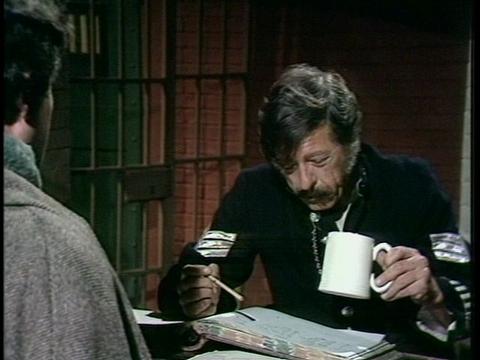
Phineas trying to persuade the police sergeant (Edwin Richfield) to release Mr Bunce
Scene 20): The Palliser drawing room; yet another of these long assembly scenes where the viewer moves from pair to trio or more people; this time each one shows a conversation on some aspect of the story, one another, or political situations; Plantagenet and Lady Glen enact their own part of their story as well as providing choral commentary intended to give the viewer the perspective the film-makers prefer us to have. To sum up, Finn is very anxious because now that he did get up and speech, he made an ass out of himself and may not get another chance to redeem himself as he has no seat lined up; he also faces a nasty insinuation from Dolly Longestaffe about his relationship with Lady Laura; Fitzgibbon still will not pay Clarkson; all the party members worried about the narrow win on the bill they had as it necessitates an election; Kennedy and Laura’s fights are growing so strong they can no longer appear amiable in public with one another; Madame Max comforts and inspirits Phineas (a role she will increasing perform and which she performs in the novel where he visits her in her house and talks intimately of his life
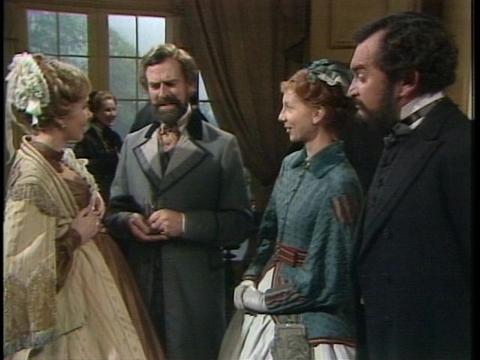
Another of Lady Glen’s big parties for politicans: we see her, the ultimate party (pun intended) man, Erle, and the Kennedys
Episode 40. “The Attack.” Scene 21) A London street: Phineas walking with Kennedy, Kennedy demanding he not see Lady Laura on Sundays (includes another aspersion on Finn’s Catholicism—something we have seen before); they part and Phineas hears the garrotters and saves Kennedy; Scene 22) Grosvenor Place: Kennedy eating beef tea; Laura brings in the hero, Kennedy all gratitude and all made up; Lady Laura leaves Violet with Kennedy to take Phineas to her father; Scene 23) Lord Brentford’s drawing room, London: Phineas now congratulated for saving a second member of the family, and offered Loughton for his reward; he slightly reluctantly accepts; Scene 24) Back in the Parliamentary chambers, Turnbull on the attack, and this time Phineas rises and ably defends the government, followed by Scene 25) in those corridors of power he is congratulated by Monk and Palliser as they leave. He has arrived. And then Phineas is approached by Mr Slide who threatens to expose his debt to Mr Clarkson and sully his relationship with Lady Laura and castigate him over sitting for yet a second rotten borough all the while he is supposedly a liberal. Now if only Mr Finn will support the secret ballot as The People’s Banner intends to …,” and Phineas refuses.
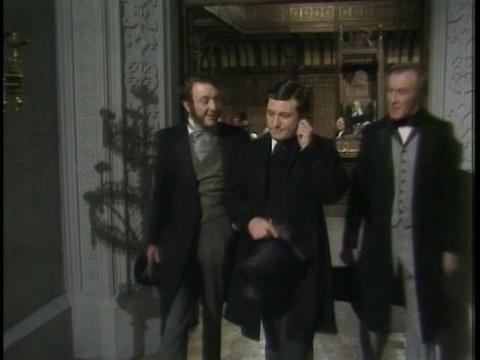
Phineas congratulated by Monk and Palliser: he has done what they hoped he would for them, spoken effectively
Sylvia
--
Posted by: Ellen
* * *
Comment
- Ellen, I watched this whole series in the last few years (on dodgy VHS tapes from the library), but now you are making me want to see it all over again, this time on DVD! I’m afraid I can’t respond in any detail as I don’t remember the series well enough, but just wanted to say that I am reading and appreciating your in-depth commentaries.
As I remember, I especially liked the portrayal of Phineas, Violet and Lady Laura in the series, as well as Plantaganet Palliser. I have difficulties with Lady Glen because I’ve disliked Susan Hampshire in other roles and find my knowledge that it’s her getting in the way.
— Judy Feb 18, 3:53pm #
commenting closed for this article
